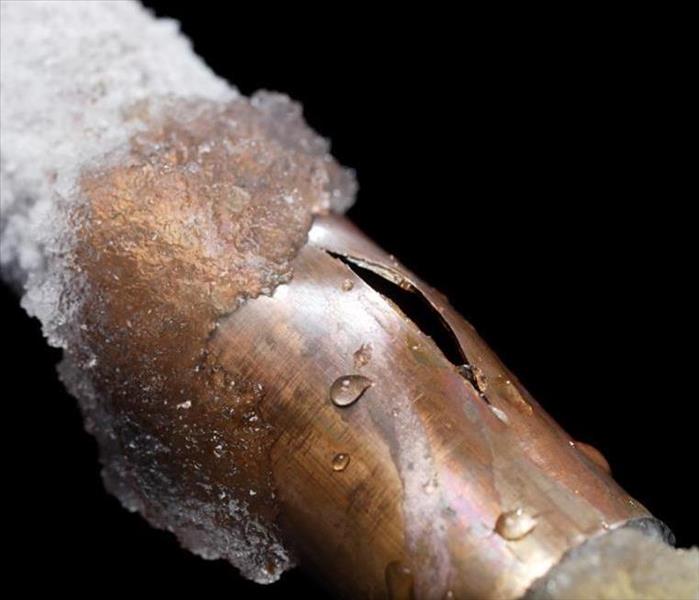What to do if your pipes Freeze
2/18/2021 (Permalink)
With the current freezing temperatures, the freezing rain and snow fall, we are receiving several calls and inquiries about how to thaw out frozen pipes.
Here are a few quick tips on how to prevent and get your pipes thawed out.
- Locate the frozen pipe – Begin your trace from the faucet that is not working and locate where the frozen pipe is.
- Open the Faucet - Before you begin attempting to thaw a frozen pipe, you will want to open the faucet that the pipe feeds water into. Make sure to open both the hot and cold handles. This will help to relieve pressure in the system and will allow the water to escape once you begin to thaw the pipe.
- Where to Begin the Thawing Process - You should always begin the thawing process near the faucet then work your way down to the blockage. This will help ensure that the melting ice and steam is able to escape through the open faucet. If you start the thawing process closer to the blockage, the melting ice could get stuck behind the blockage, creating more pressure in the pipe, and increasing the chances the pipe will burst.
- Thawing Exposed Pipes -If the frozen pipe is in an area you can easily access, you have several options for attempting to thaw the pipe. You should continue to apply the heat until the water escaping from the faucet returns to full strength. Here are four options for thawing an exposed pipe.
- Hair Dryer- One of the easiest ways to thaw a pipe is by using a hairdryer. Simply turn the dryer on and point the heat at the pipe, beginning with the portion closest to the faucet. As with any electrical product, take the proper precautions and avoid encountering water when operating the device.
- Heat Lamp or Portable Space Heater- Another method to thaw the pipe is to use a heat lamp or portable space heater. Position the device so that the heat can reach the frozen pipe. This indirect heat can help to quickly thaw a pipe. Again, make sure to comply with the safety measures and precautions on the device you are using and keep the device away from water. NOTE - This should be closely monitored so not to start a fire.
- Hot Towels- Another way to thaw a frozen pipe is to wrap towels that have been dipped in hot water around the pipe. This can help to slowly thaw the blockage.
- Electrical Heating Tape- A final option is to apply electrical heating tape directly to the pipe. This tape distributes heat throughout the pipe. You can purchase electrical heating tape that you plug in and unplug as needed or you can purchase heating tape that shuts off on its own.
- Things to Avoid - Never attempt to thaw a pipe using an open flame, such as a propane torch. This can not only damage the pipe, but it can also start a fire in your property.
- If the Pipe Bursts - If a frozen water pipe does burst, the first thing you should do is shut off the main water line into your property. This will prevent additional water from flowing and damaging your property. You should know where the shut-off valves are for each of your properties and for each unit. There are usually smaller shut-off valves located near sinks and toilets, but the main shut-off valve is often located near the water meter.
- If the Break is Outside of your House – If the water line break is outside of your house, contact your local water department.
- Call a Professional - Call a Professional- If you are unable to thaw the pipe, unable to locate the frozen pipe, do not feel comfortable thawing a pipe yourself or if a pipe bursts, or If you do have a problem with any plumbing issue, contact a licensed plumber or contact SERVPRO® of Mayes and Wagoner Counties and we can recommend a reputable plumbing service.
For more Tips and Tricks on how to prevent frozen pipes, check out more of our blogs at https://www.SERVPROmayesandwagonercounties.com/blog
SERVPRO® of Mayes and Wagoner Counties specializes in Fire and Water Cleanup and Restoration.
If you have any questions, call your SERVPRO® of Mayes and Wagoner Counites, 918-486-1055. 24/7 Emergency Response Always FREE Estimates for any job.






 24/7 Emergency Service
24/7 Emergency Service
